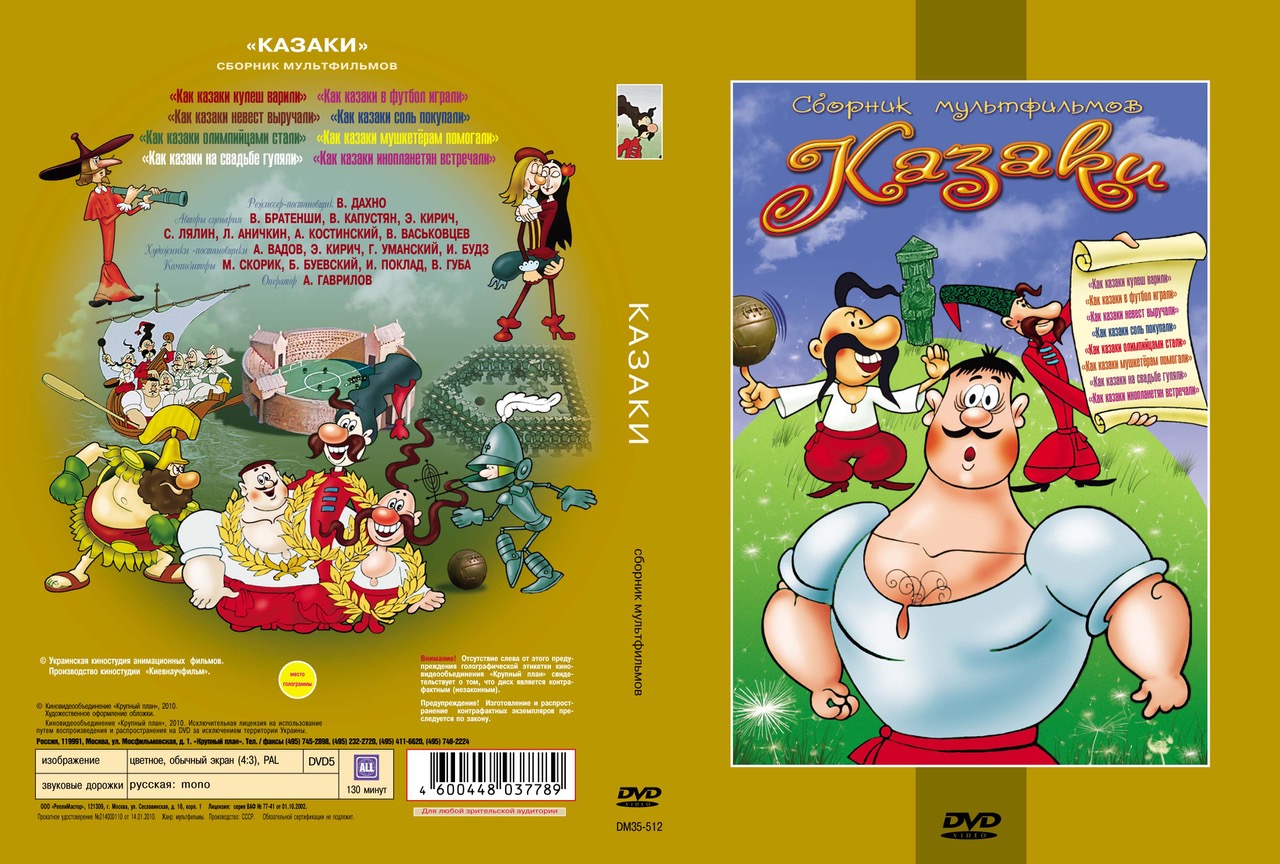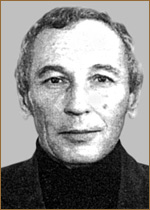Title of the work
Studio / Production Company
Country of the First Edition
Original Language
First Edition Date
First Edition Details
Як козаки олімпійцями стали [How Cossacks Became Olympians (Iak kozaky olimpiĭtsiamy staly)]. Directed by Volodymyr Dakhno, written by Volodymyr Dakhno and Eduard Kyrych. Composer Boris Buevsky. Kyiv: Kyivnaukfilm, 1978.
Running time
Date of the First DVD or VHS
Awards
1979 – International festival of sports movies in Leningrad – bronze medal.
Genre
Animated films
Hand-drawn animation (traditional animation)*
Humor
Short films
Target Audience
Children (6+)
Cover

The DVD cover courtesy of Film Video Association “Крупный план” [Close-up (Krupnyĭ plan)] close-up.ru (accessed: February 4, 2019).
Author of the Entry:
Hanna Paulouskaya, University of Warsaw, hannapa@al.uw.edu.pl
Peer-reviewer of the Entry:
Dorota Mackenzie, University of Warsaw, dorota.mackenzie@gmail.com
Elizabeth Hale, University of New England, ehale@une.edu.au
Elżbieta Olechowska, University of Warsaw, elzbieta.olechowska@gmail.com

Boris Buevsky
, b. 1935
(Composer)
Buevsky Boris (Буєвський Борис; Буевский Борис) – a Ukrainian composer of classical and popular music, author of music for ballets and cinema. His popular music was especially popular in 1960s and 1970s in the USSR. From 1993 he lives in Belgium.
Bio prepared by Hanna Paulouskaya, University of Warsaw, hannapa@al.uw.edu.pl

The portrait of Volodymyr Dakhno courtesy of kino-teatr.ru database.
Volodymyr Dakhno
, 1932 - 2006
(Animator, Director)
Dakhno Volodymyr (Дахно Володимир; Дахно Владимир; Dakhno Vladimir) – a famous Ukrainian animator, director, People’s Artist of Ukraine.
Volodymyr Dakhno studied architecture (1955) and came to animation in 1960s in collaboration with another architect, Mark Draitsun (also an animator of the “Cossack” series).
The most famous of his animations are movies from the series “Cossacks”, which became a trademark of the Ukrainian animation studio “Kyivnauchfilm”.
Bio prepared by Hanna Paulouskaya, University of Warsaw, hannapa@al.uw.edu.pl

Eduard Kyrych
, b. 1942
(Animator, Screenwriter)
Kyrych Eduard (Кирич [Кірич] Едуард; Кирич Эдуард; Kirych Eduard; Kirich Eduard) – a Ukrainian animator and a screen-writer. He was honoured with the title of a National artist of Ukraine (2004). He collaborated with Volodymyr Dakhno on the “Cossack” Series.
Bio prepred by Hanna Paulouskaya, University of Warsaw, hannapa@al.uw.edu.pl
Summary
The movie is the fifth in a series about the Cossacks produced by Volodymyr Dakhno between 1967 and 1995. The main heroes of the series are three Cossacks – Grai, the smartest and the tallest; Oko, the smallest one, but brave and a good shot (oko means “eye” in Ukrainian); Tur, the biggest and strongest, who is shy and sentimental (tur means “aurochs” in Ukrainian).
The movie starts with a scene when the Cossacks are preparing kasha (a traditional Slavic cereal omnipresent in fairy tales) in a huge pot sitting on the top of a mountain.
Meanwhile old Zeus is sleeping in his mansion on mount Olympus. He is disturbed by a loud noise from Earth. We see that the noise is produced by wars initiated by Mars.
Zeus, trying to restore silence and to stop the war, switches off the light in his mansion (and the night starts), he turns on the shower in his bathroom making rain and a flood on Earth, he pulls out the plug and drains the seas, but the war continues despite his efforts. (And the Cossacks eat the kasha despite the circumstances).
Then, smoking a pipe and looking at rings of smoke, Zeus decides to organize the Olympic Games (shouting “Eureka!”). The Cossacks see the rings and set out for Olympia.
Zeus builds a stadium with a football field inside and invites everybody to the games: Ласкаво просимо (Welcome, Laskavo prosymo). Warriors throw away their armour, undress and run towards the stadium. The Cossacks train preparing for the games.
But Mars intervenes another time and starts besieging the stadium.
Zeus, full of anger, calls Hades on the phone and asks him to lock up Mars in a far away cell. Two Cyclops bring Mars to the underworld, and he is put behind bars. However Hades hangs the key close to the cell and Mars asks Sisyphus, who rolls his stone in vain, to open the cell. Sisyphus helps Mars and is closed in the cell himself. Both are happy – Sisyphus can rest, Mars can go back to Earth.
Meanwhile the Olympics are about to begin, and the Cossacks go to Olympia to participate in them. They meet Mars, when he comes out through a manhole.
The Olympics start and teams from different cities are presented in the stadium. Zeus is watching through a telescope. We see teams of Attica, Sparta and Troy.
Mars has new plans to disturb the Olympics and the Cossacks try to stop him. They fence (Grai), wrestle (Tur), throw discus (Tur). The Cossacks win every time. Mars escapes in the river rowing on a log, and the Cossacks pursue him swimming and rowing. Mars leaves his helmet and tries to escape into the mountains. The Cossacks use the helmet as a sledge and run to Olympia after the god.
They meet him in an entrance of a temple in Olympia, and a boxing match begins between Oko and Mars. Zeus and the public come to see the competition. Oko wins.
At that moment Hades and the Cyclops come and take Mars to the underworld. The Cossacks receive three laurel garlands from Zeus.
Analysis
This was the first Soviet animated movie dedicated to the Olympics of 1980.* The movie uses the most popular topic in the USSR in the context of the Olympics – peace and war. The Olympics are established in order to bring peace, and the quarrelsome Mars tries to disturb them. The Cossacks are the heroes who stop Mars and allow the Games to go on. They do it not by fight, but by competing in sporting manner.
Choosing the Cossacks as characters is important. The first reason was that the Cossacks series was already famous in the USSR. Another important reason was the Ukrainian tradition of connections between the Cossacks and antiquity. There was a poem written by Ivan Kotliarevsky in 1798–1842 that was a burlesque interpretation of Virgil’s Aeneid. It was written in Ukrainian and was extremely popular in Russia and Ukraine and became a classical text of Ukrainian literature. According to Kotliarevsky, Aeneas is a Cossack and all his adventures are presented in a satiric, parodic way. There was also an animation produced in 1969 by Nina Vasylenko based on this poem (Пригоди козака Енея [Adventures of Aeneas the Cossack (Pryhody kozaka Eneia)]). So Volodymyr Dakhno follows a tradition recognizable by the audience.
The movie is very simple and entertaining, and it has no didactic character.
However it is based on an assumed knowledge of the Greek mythology – for example, Sisyphus or Cyclops are introduced in the movie without an explanation.
The movie is silent, only subtitles are added in Ukrainian, however the title of the movie and titles are in Russian. The Cyrillic letters are stylized on the Greek alphabet to underline the character of the topic.
Though all the events are happening in Ancient Greece, the world of Zeus is very contemporary – there is a telephone, a lift or a sewage system.
* Borodin, Georgyĭ [Бородин, Георгий], “Олимпиада как мультфильм” [Olympics as an Animation (Olimpiada kak mul'tfilm)], Сеанс [Seans (Seans)] (2004): 55–57, online resource http://seance.ru/blog/chtenie/olympics_animation/ (accessed on February 01, 2018) .
Further Reading
Borodin, Georgyĭ [Бородин, Георгий], “Олимпиада как мультфильм” [Olympics as an Animation (Olimpiada kak multfilm)], Сеанс [Seans (Seans)], (2014): 55–57, online resource http://seance.ru/blog/chtenie/olympics_animation/ (accessed February 01, 2018).
Paulouskaya, Hanna, “Vergil travestied into Ukrainian and Belarusian”, in The Afterlife of Virgil, in Peter Mack and John North, eds., Bulletin of the Institute of Classical Studies, Supplement, 136, London: Institute of Classical Studies, 2017, 101–122.
Pushkina, Maria, "Entry on: Aeneid. Travestied Inside Out into Little Russian language by I. Kotliarevsky [Енеида. На малороссійскій языкъ перелиціованная И. Котляревскимъ (Eneida. Na malorossiĭskiĭ iazyk perelitsiovannaia I. Kotlarevskim)]," peer-reviewed by Elżbieta Olechowska and Susan Deacy, in Our Mythical Childhood Survey, Warsaw: University of Warsaw, 2018. Link: http://omc.obta.al.uw.edu.pl/myth-survey/item/513.
Addenda
The Remaining Production Credits
Art director – Ivan Mazepa,
Animators – Adolf Pedan, Efrem Pruzhansky, Nina Churylova and others,
Sound director – Ihor Pohon,
Camera man – Anatoliy Havrylov,
Composer – Boris Buevsky.
Information about the film in movie databases:
www.kinopoisk.ru (accessed: January 31, 2022),
www.imdb.com (accessed: January 31, 2022),
kino-teatr.ru (accessed: January 31, 2022),
animator.ru (accessed: January 31, 2022).


